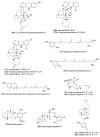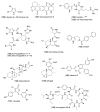Marine pharmacology in 2005-6: Marine compounds with anthelmintic, antibacterial, anticoagulant, antifungal, anti-inflammatory, antimalarial, antiprotozoal, antituberculosis, and antiviral activities; affecting the cardiovascular, immune and nervous systems, and other miscellaneous mechanisms of action
- PMID: 19303911
- PMCID: PMC2735450
- DOI: 10.1016/j.bbagen.2009.03.011
Marine pharmacology in 2005-6: Marine compounds with anthelmintic, antibacterial, anticoagulant, antifungal, anti-inflammatory, antimalarial, antiprotozoal, antituberculosis, and antiviral activities; affecting the cardiovascular, immune and nervous systems, and other miscellaneous mechanisms of action
Abstract
Background: The review presents the 2005-2006 peer-reviewed marine pharmacology literature, and follows a similar format to the authors' 1998-2004 reviews. The preclinical pharmacology of chemically characterized marine compounds isolated from marine animals, algae, fungi and bacteria is systematically presented.
Results: Anthelmintic, antibacterial, anticoagulant, antifungal, antimalarial, antiprotozoal, antituberculosis and antiviral activities were reported for 78 marine chemicals. Additionally 47 marine compounds were reported to affect the cardiovascular, immune and nervous system as well as possess anti-inflammatory effects. Finally, 58 marine compounds were shown to bind to a variety of molecular targets, and thus could potentially contribute to several pharmacological classes.
Conclusions: Marine pharmacology research during 2005-2006 was truly global in nature, involving investigators from 32 countries, and the United States, and contributed 183 marine chemical leads to the research pipeline aimed at the discovery of novel therapeutic agents.
General significance: Continued preclinical and clinical research with marine natural products demonstrating a broad spectrum of pharmacological activity will probably result in novel therapeutic agents for the treatment of multiple disease categories.
Figures
References
-
- Mayer AMS, Lehmann VKB. Marine pharmacology in 1998: marine compounds with antibacterial, anticoagulant, antifungal, anti-inflammatory, anthelmintic, antiplatelet, antiprotozoal, and antiviral activities;with actions on the cardiovascular, endocrine, immune, and nervous systems; and other miscellaneous mechanisms of action. The Pharmacologist. 2000;42:62–69.
-
- Mayer AMS, Hamann MT. Marine pharmacology in 1999: compounds with antibacterial, anticoagulant, antifungal, anti-inflammatory, anthelmintic, anti-inflammatory, antiplatelet, antiprotozoal and antiviral activities;affecting the cardiovascular, endocrine, immune, and nervous systems; and other miscellaneous mechanisms of action. Comp Biochem Physiol C: Pharmacol. 2002;132:315–339. - PubMed
-
- Mayer AMS, Hamann MT. Marine pharmacology in 2001–2002: marine compounds with anthelmintic, antibacterial, anticoagulant, antidiabetic, antifungal, anti-inflammatory, antimalarial, antiplatelet, antiprotozoal, antituberculosis, and antiviral activities; affecting the cardiovascular, immune and nervous systems and other miscellaneous mechanisms of action. Comp Biochem Physiol C: Pharmacol. 2005;140:265–286. - PMC - PubMed
-
- Mayer AMS, Rodriguez AD, Berlinck RG, Hamann MT. Marine pharmacology in 2003–4: marine compounds with anthelmintic antibacterial, anticoagulant, antifungal, anti-inflammatory, antimalarial, antiplatelet, antiprotozoal, antituberculosis, and antiviral activities; affecting the cardiovascular, immune and nervous systems, and other miscellaneous mechanisms of action. Comp Biochem Physiol C: Pharmacol. 2007;145:553–581. - PMC - PubMed
-
- Mayer AMS, Hamann MT. Marine pharmacology in 2000: marine compounds with antibacterial, anticoagulant, antifungal, anti-inflammatory, antimalarial, antiplatelet, antituberculosis, and antiviral activities; affecting the cardiovascular, immune, and nervous systems and other miscellaneous mechanisms of action. Mar Biotechnol (NY) 2004;6:37–52. - PMC - PubMed
Publication types
MeSH terms
Substances
Grants and funding
LinkOut - more resources
Full Text Sources
Other Literature Sources
Medical




